Kansas is home to rolling fields of wheat, towering sunflowers, and colorful wildflowers. However, the Sunflower State is also home to a number of dangerous plants that can pose a threat to humans and animals alike. From the infamous poison ivy to lesser-known species like jimsonweed and poison hemlock, Kansas harbors a variety of toxic flora that should be handled with caution.
In this article, we’ll explore some of the most dangerous plants found in Kansas. We’ll learn how to identify and avoid them. So, whether you’re a seasoned outdoors person or simply a curious nature lover, in Don’t Touch These Seven Dangerous Plants That Grow in Kansas you’ll discover the hazards lurking in Kansas’s greenery.
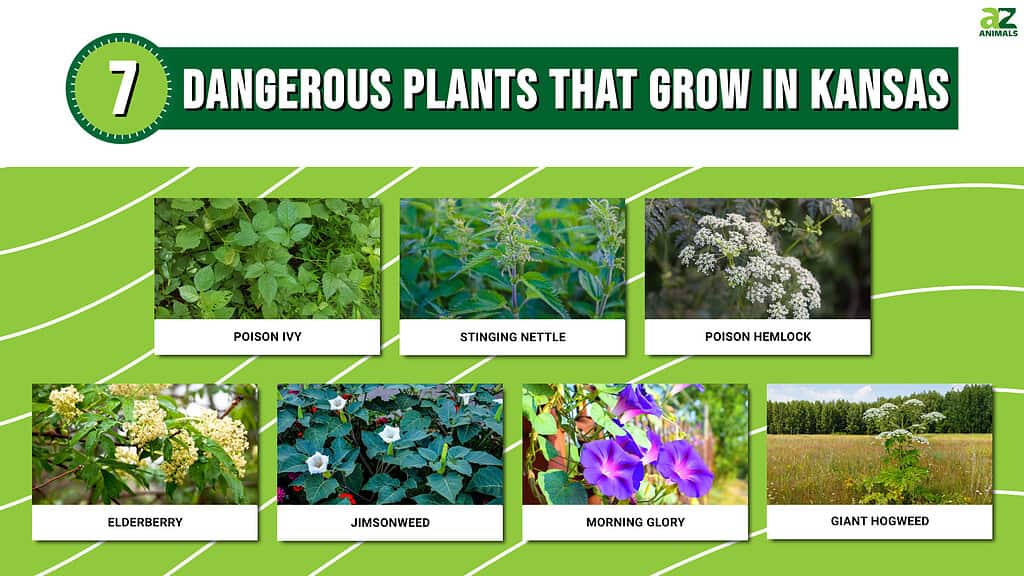
What Makes a Plant Dangerous?
Plants can be considered dangerous for a variety of reasons, including toxicity, allergenic properties, or also physical characteristics that can cause harm. Some plants contain poisonous compounds that can cause illness or death if ingested. Poison hemlock plant contains the toxin coniine, which can cause respiratory failure and death. Certain plants can cause allergic reactions in sensitive individuals. Poison ivy contains an oil called urushiol. Urushiol can cause a painful rash in people who come into contact with it.
Prostrate vining plants, like creeping thyme, and ground ivy, grow close to the ground and can also spread quickly. They often cover large areas of ground. If they grow in areas where people walk or stand, the vining stems could become entangled around feet. This can lead to trips and falls, and their resulting injuries. Other plants have thorns, spines, or other physical characteristics that can cause injury. The giant hogweed plant has sap that can cause severe burns and also blisters on the skin. Its sap can also cause blindness if it gets into the eyes. It’s crucial to be aware of the potential dangers associated with plants, especially when exploring unfamiliar areas. If you are unsure about the safety of a particular plant, it’s best to avoid contact. Read on to learn about the dangerous plants found in Kansas.
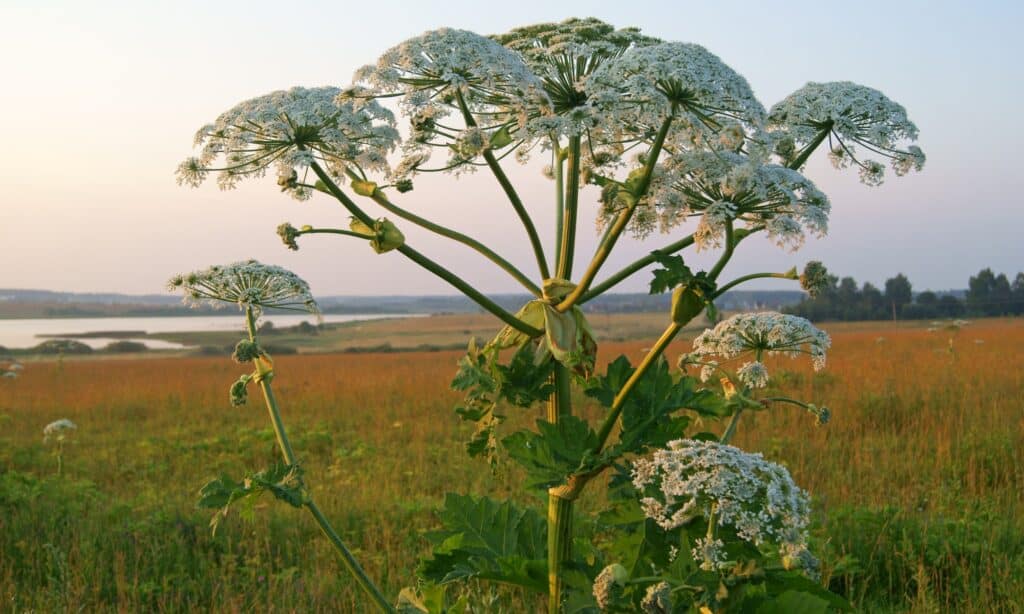
The giant hogweed plant (
Heracleum mantegazzianum) has sap that can cause severe burns and also blisters on the skin, and its sap can also cause blindness if it gets into the eyes.
©iStock.com/hapelena
Don’t Touch These Seven Dangerous Plants That Grow in Kansas
Poison Ivy
Poison ivy (Toxicodendron radicans) is found throughout much of Kansas. It grows in wooded areas, along the edges of fields, and also along streams or rivers. It is a vine or shrub that can grow up to several feet (meters) tall. Each leaf of poison ivy has three leaflets, hence the popular saying leaves of three, let it be. The leaflets are usually oval or pointed, and can have a smooth or slightly toothed edge. The surface of the leaves is typically shiny and also smooth.
In the spring and early summer, poison ivy leaves may have a reddish tint. In the fall, poison ivy may produce clusters of small white or green berries. Poison ivy can grow as a low shrub or climb as a vine. As a vine, it uses aerial roots to attach itself to trees or other structures. It contains an oil called urushiol. Urushiol can cause a painful, itchy rash in most people who come into contact with it. The oil can be spread by direct contact with the plant. It can also be spread by touching objects or clothing that has come into contact with the oil.
It’s important to learn to identify poison ivy and take precautions to avoid contact with it. If you do come into contact with poison ivy, it’s important to wash the affected area with soap and water. This will reduce the risk of developing a rash. If a rash does develop, over-the-counter remedies like calamine lotion or hydrocortisone cream can help alleviate symptoms.
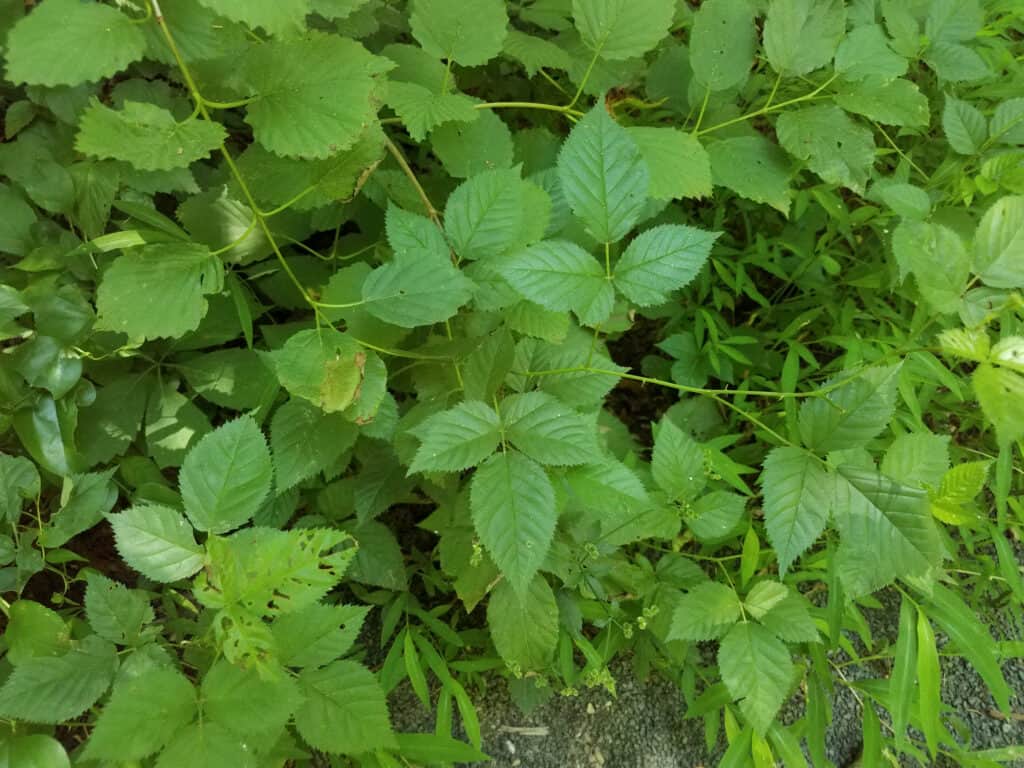
Poison ivy is well known for causing a painful and itchy skin rash.
©iStock.com/Justin Smith
Stinging Nettle
Stinging nettle (Urtica dioica) grows in Kansas, particularly in moist, shaded areas such as riverbanks and forest edges. This plant is an herbaceous perennial plant that can grow up to several feet (meters) tall. It has stinging hairs on its leaves and stems that can cause a painful rash or irritation if touched. Despite its stinging properties, stinging nettle is also used for medicinal and culinary purposes. It contains a range of nutrients and compounds that may have health benefits. If you plan to harvest stinging nettle:
- Wear protective clothing: When harvesting or handling stinging nettle, it’s important to wear gloves, long sleeves, and pants to avoid getting stung.
- Approach from the side: To avoid brushing against the stinging hairs on the leaves and stem of the nettle plant, approach it from the side and try to avoid touching it.
- Use scissors: To harvest stinging nettle, use a pair of sharp scissors to snip off the leaves and stems near the base of the plant.
- Blanch or cook before consuming: To remove the stinging properties of the nettle plant, blanch it in boiling water for a few seconds or cook it thoroughly before consuming it.
- Dispose of carefully: After harvesting or handling stinging nettle, dispose of it carefully in a sealed container or bag to avoid contact with other people or pets.

Despite its stinging properties, stinging nettle is also used for medicinal and culinary purposes.
©iStock.com/Dmitri Zelenevski
Poison Hemlock
Poison hemlock (Conium maculatum) is a highly poisonous plant that is native to Europe and North Africa. It has been introduced to many parts of the world, including North America. It is a member of the carrot family and can grow up to six feet (1.8 m) tall. Its green stems are often spotted with purple or red.
Poison hemlock has fern-like leaves that are bright green and shiny, with a smooth, hairless surface. The stems are hollow and have purple or red spots. The plant produces clusters of small white flowers that are arranged in umbrella-shaped clusters. All parts of the poison hemlock plant are highly toxic, containing a potent neurotoxin called coniine. Ingesting even a small amount of the plant can be fatal to humans and animals.
Skin contact with the plant can also cause irritation. The symptoms of poison hemlock poisoning can include vomiting, diarrhea, stomach pain, confusion, dizziness, seizures, paralysis, and respiratory failure. In severe cases, it can be fatal.
Historical Significance
Poison hemlock has a long and deadly history. It is believed to have been used as a poison in ancient Greece, where it was reportedly used to execute the philosopher Socrates. It has also been used for medicinal purposes in some cultures, but its toxicity makes it a dangerous choice for any use.
Because poison hemlock is so toxic, it’s important to take precautions when handling or removing it. Wear gloves and protective clothing when handling the plant, and make sure to dispose of all parts of the plant carefully. Poison hemlock is a highly dangerous and toxic plant that should be avoided if encountered. If you suspect that you or someone else has come into contact with poison hemlock, seek medical attention immediately.

The stems of poison hemlock are hollow and have purple or red spots, and the plant produces clusters of small white flowers that are arranged in umbrella-shaped clusters.
©iStock.com/gabrielabertolini
Elderberry
Elderberry (Sambucus) is native to Kansas and can be found growing in the wild throughout the state. It is a deciduous shrub or small tree that can grow up to 32 feet (10 m) tall. The leaves are compound and opposite, meaning they grow in pairs on opposite sides of the stem. Each leaf is made up of five to nine leaflets that are two to six inches (5-15 cm) long and 1-3.5 inches (3-9 cm) wide.
The leaflets are pointed and have a serrated edge. In late spring or early summer, the elderberry plant produces large clusters of small, creamy-white flowers. The flowers are about 0.2 inches (5 mm) in diameter. They have a sweet, musky scent. In late summer or early fall, the plant produces clusters of small, dark purple or black berries that are about 0.2-0.25 inches (5-6 mm) in diameter. The bark of the Elderberry plant is light brown or gray and has shallow furrows and ridges.
Elderberries
While elderberries themselves are not dangerous, other parts of the elderberry plant can be toxic, including the leaves, stems, and roots. These parts of the plant contain a chemical called cyanogenic glycoside, which can release cyanide when ingested. Therefore, it’s important to use caution when handling or consuming elderberry and to only consume ripe berries. The berries are juicy and sweet and are often used to make jams, jellies, and wine.
Elderberry is considered safe when consumed in moderation and in the proper form. However, individuals with certain health conditions or who are taking medications to prevent organ transplant failure, multiple sclerosis, or certain autoimmune diseases should consult with their healthcare provider before consuming elderberry products, as they may interact with medications or exacerbate certain health issues.

While elderberries themselves are not dangerous, other parts of the elderberry plant can be toxic, including the leaves, stems, and roots. Pictured: red elderberry
(Sambucus racemosa)
©Erika J Mitchell/Shutterstock.com
Jimsomweed
Jimsonweed (Datura stramonium) is one of the seven dangerous plants in Kansas. It’s a plant that belongs to the nightshade family (Solanaceae). It is known for its distinctive trumpet-shaped white or lavender flowers and large, prickly seed pods. The plant can grow up to 5 feet (1.5 m) tall. It has large, irregularly lobed leaves that are often covered in fine hairs. The flowers of jimsonweed are about 3 to 6 inches (7-15 cm) long and trumpet-shaped. Five points flare out at the mouth of the flower. They have a strong, sweet fragrance that can be pleasant to some people, but can cause headaches or dizziness in others. The seed pods of jimsonweed are round, spiny balls that can grow up to 2 inches (5 cm) in diameter. When mature, the pods split open to release small black seeds that are highly toxic.
Jimsonweed is considered dangerous due to the toxic compounds it contains, particularly the alkaloids atropine, hyoscyamine, and scopolamine. These alkaloids have potent anticholinergic properties. Anticholinergic compounds block the action of acetylcholine, a type of neurotransmitter. This can cause a range of harmful effects when ingested or inhaled. Symptoms include dry mouth, blurred vision, hallucinations, confusion, agitation, delirium, seizures, and even coma or death. The plant can also cause respiratory distress and even respiratory failure if the seeds or leaves are inhaled. Jimsonweed is often used recreationally for its psychoactive effects, but its use can be extremely dangerous and even fatal. The plant should be handled with extreme caution, and ingestion or inhalation should be avoided at all costs. It can be especially dangerous for children and pets, who may be more susceptible to the plant’s toxic effects.
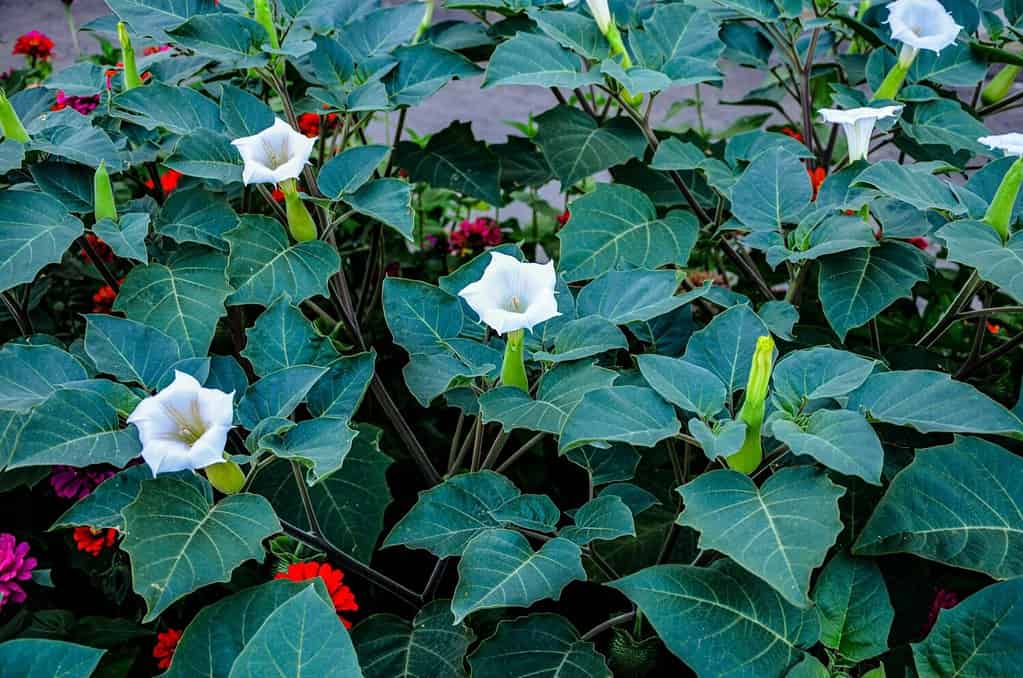
Jimsonweed has large, irregularly lobed leaves that are often covered in fine hairs.
©weha/Shutterstock.com
Morning Glory
Ipomoea tricolor, also known as morning glory, is a species of flowering plant that is native to the Americas but is now found throughout the world as an ornamental plant. Morning Glory contains a variety of alkaloids that can produce psychoactive effects when consumed, particularly when the seeds are ingested. While morning glory is often used recreationally by humans seeking a psychedelic experience, it can be dangerous to animals if ingested. The seeds contain a variety of alkaloids, including lysergic acid amide (LSA), which can produce effects similar to those produced by LSD in humans. In animals, ingestion of morning glory seeds can lead to a range of symptoms, including agitation, tremors, seizures, and even death.
In addition to their psychoactive effects, morning glory seeds can also be toxic to animals due to the presence of indole alkaloids, which can cause vomiting, diarrhea, and other digestive symptoms when ingested in large quantities.
It’s crucial to keep morning glory plants and seeds away from animals, as ingestion can lead to a range of harmful effects. If you suspect that your pet has ingested morning glory seeds or other toxic plants, seek veterinary attention immediately. This is why the morning glory is one of the seven dangerous plants in Kansas.
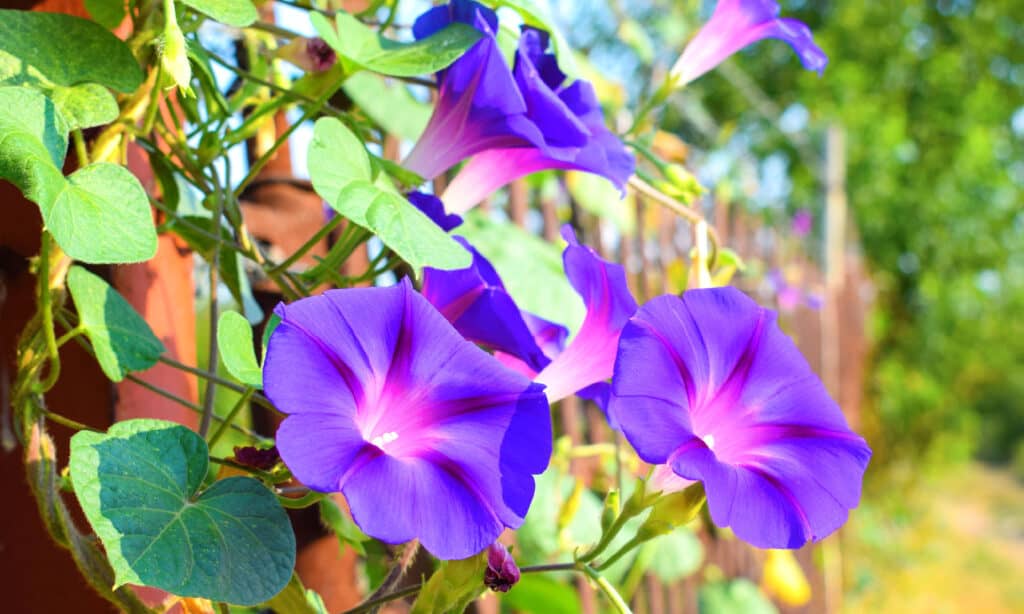
While morning glory is often used recreationally by humans seeking a psychedelic experience, it can be dangerous to animals if ingested.
©iStock.com/Wakhron
Giant Hogweed
Giant hogweed (Heracleum mantegazzianum) is one of the seven dangerous plants in Kansas. It is native to the Caucasus region of Eurasia but has been introduced to many other parts of the world, including North America and Europe. It is a large, flowering plant that can grow up to 16 feet (5 m) in height. The plant has white flower clusters. While the plant may seem impressive, it is important to note that it is highly dangerous and can cause severe skin reactions upon contact. The sap of the giant hogweed contains a chemical called furanocoumarins, which can cause severe skin reactions. The sap is most potent when the plant is exposed to sunlight, as the chemical is activated by UV light.
Skin reactions caused by giant hogweed can be severe and also long-lasting. They often appear within 24-48 hours of exposure and include burning, itching, and blistering of the skin. In some cases, the reaction can be so severe that it leads to scarring and pigmentation changes. If the sap comes into contact with the eyes, it can cause temporary or permanent blindness.
Giant hogweed is highly invasive and can quickly spread throughout an area, displacing native plants and damaging ecosystems. If you do come into contact with the plant, it is important to wash the affected area thoroughly with soap and water and to seek medical attention if necessary.
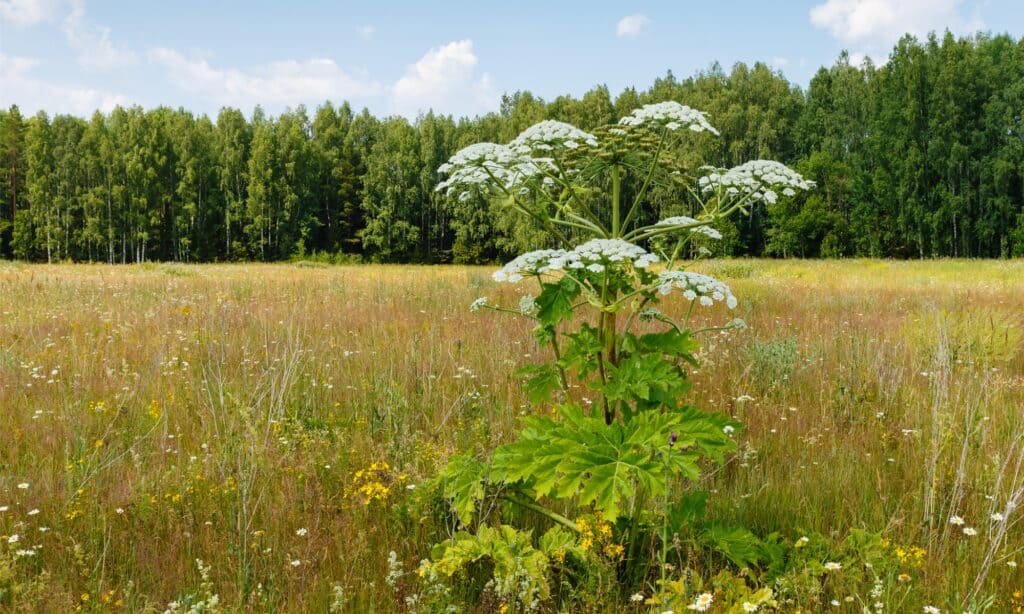
Giant hogweed is a large, flowering plant that can grow up to 16 feet (5 m) in height.
©iStock.com/Mieszko9
Summary Of 7 Dangerous Plants That Grow in Kansas
| Number | Dangerous Plant |
|---|---|
| 1 | Poison Ivy |
| 2 | Stinging Nettle |
| 3 | Poison Hemlock |
| 4 | Elderberry |
| 5 | Jimsonweed |
| 6 | Morning Glory |
| 7 | Giant Hogweed |
The photo featured at the top of this post is © Tim Mainiero/Shutterstock.com
Thank you for reading! Have some feedback for us? Contact the AZ Animals editorial team.







